The Samsung 960 EVO (1TB) Review
by Billy Tallis on November 15, 2016 10:00 AM ESTSequential Read Performance
The sequential read test requests 128kB blocks and tests queue depths ranging from 1 to 32. The queue depth is doubled every three minutes, for a total test duration of 18 minutes. The test spans the entire drive, and the drive is filled before the test begins. The primary score we report is an average of performances at queue depths 1, 2 and 4, as client usage typically consists mostly of low queue depth operations.
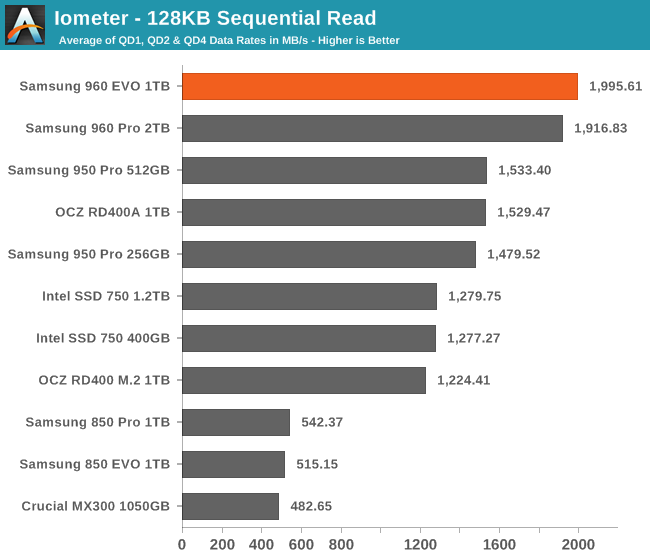
The 960 EVO provides slightly higher sustained sequential read speeds than the 960 Pro in a test where both are largely thermally limited. No other SSD comes close to offering this level of performance at low queue depths.
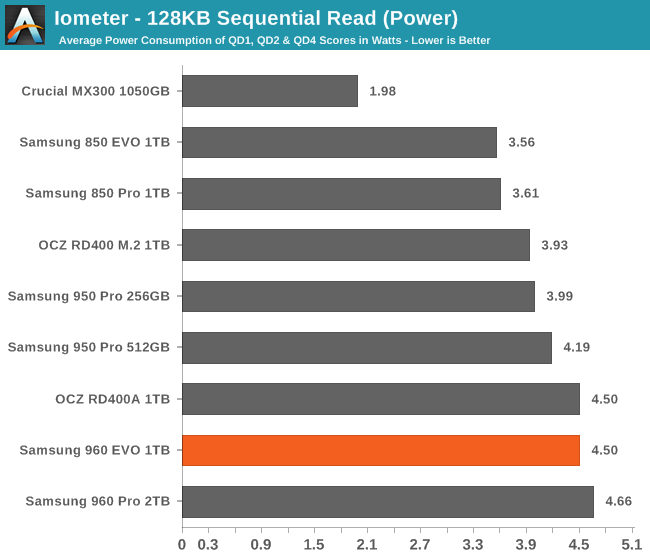
With power consumption slightly lower than the 960 Pro, the 960 EVO actually manages to set an efficiency record.
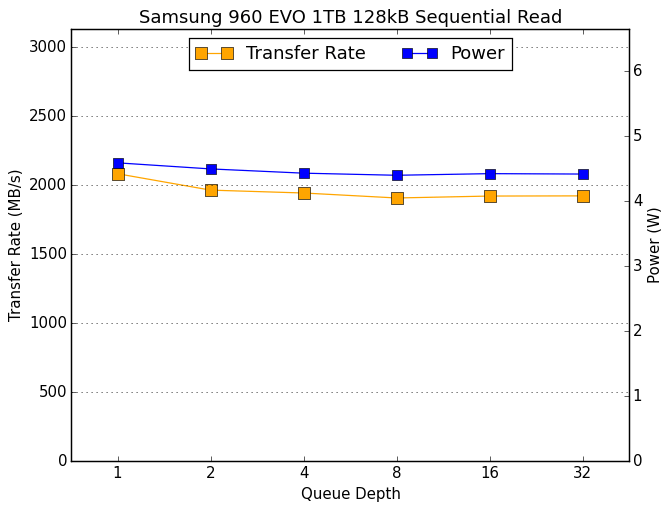 |
|||||||||
The competing drives that have large heatsinks can provide better performance at higher queue depths, but within the constraints of the M.2 form factor Samsung has a huge advantage.
Sequential Write Performance
The sequential write test writes 128kB blocks and tests queue depths ranging from 1 to 32. The queue depth is doubled every three minutes, for a total test duration of 18 minutes. The test spans the entire drive, and the drive is filled before the test begins. The primary score we report is an average of performances at queue depths 1, 2 and 4, as client usage typically consists mostly of low queue depth operations.
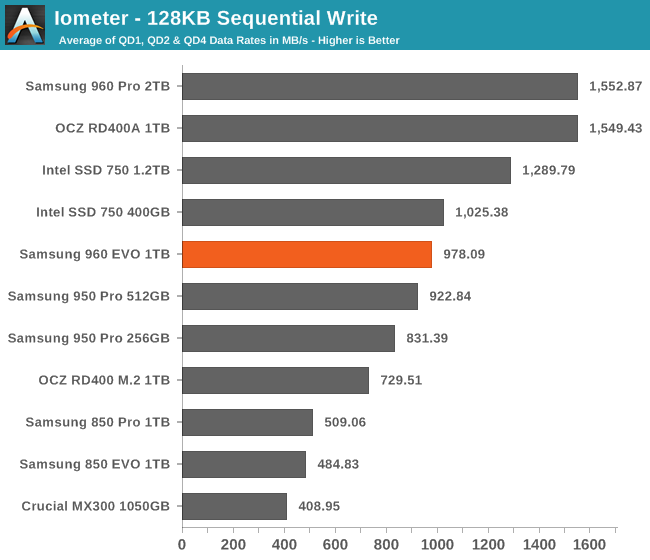
The sustained sequential write speed of the 960 EVO is far slower than the 960 Pro and several of the better-cooled competitors, but the 960 EVO is actually slightly faster than last year's 950 Pro.
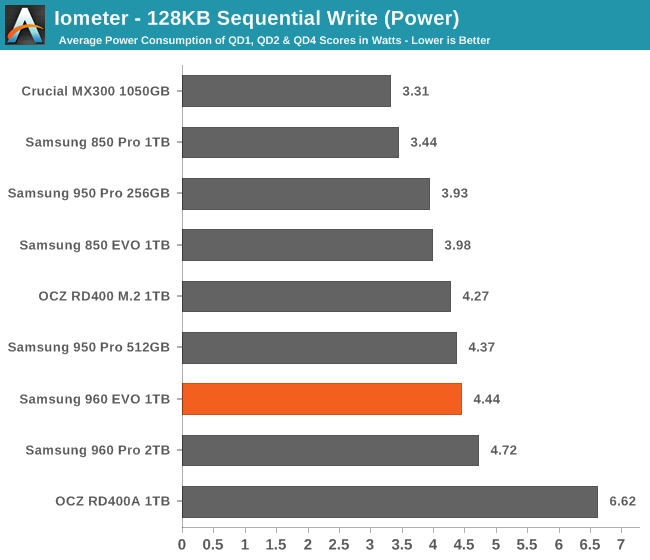
The 960 EVO doesn't break any records for power efficiency, but only because the 960 Pro exists. The MLC-based competition is less efficient than the TLC-based 960 EVO.
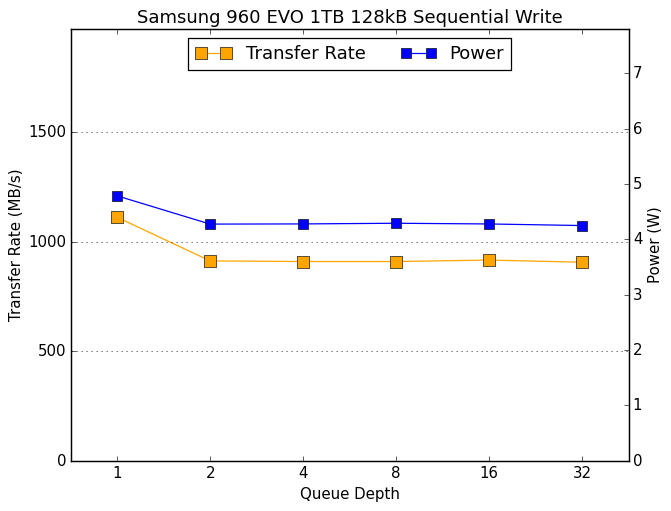 |
|||||||||
For almost all of the sequential write speed test, the 960 EVO is thermally limited, but it is clearly able to do much more within that limit than the 950 Pro or OCZ RD400 could.










87 Comments
View All Comments
SaolDan - Tuesday, November 15, 2016 - link
Neat!jwhannell - Tuesday, November 15, 2016 - link
Do wantnathanddrews - Tuesday, November 15, 2016 - link
can hazedward1987 - Friday, December 2, 2016 - link
I've never seen such a demand for nvme ssd like samsung 960 evo. They are sold only on preorders basis. Looks like the only available capacity is 250GB https://www.span.com/search/960_space_evo/-SamsungEKFxWtB - Wednesday, November 16, 2016 - link
Yea!yankeeDDL - Tuesday, November 15, 2016 - link
The 960 EVO is today, what the 850 EVO was a couple of years ago. Buying anything else makes little sense.The 850 EVO is still today an excellent SSD with a fantastic price/performance ratio.
I am happy to see such impressive improvements: I only hope we don't need to wait 2 years to see some worthy competitor ...
Ninhalem - Tuesday, November 15, 2016 - link
Only if you have 480 USD to spend on a 1 TB SSD. If you don't (and many people don't need those read/write speeds), then something like the Mushkin Reactor 1 TB can be had for half the cost.TheinsanegamerN - Tuesday, November 15, 2016 - link
While I agree, it's a bit of apples to oranges. The reactor is a sata III SSD, not a NVMe class SSD. Compared to other NVMe drives, the 960 evo is a great performance per dollar value.ImSpartacus - Tuesday, November 15, 2016 - link
I think the confusion arises from the op not specifying that he was only talking about nvme m.2 drives.ddriver - Tuesday, November 15, 2016 - link
It doesn't really matter when the speed doesn't result in any tangible practical improvements.